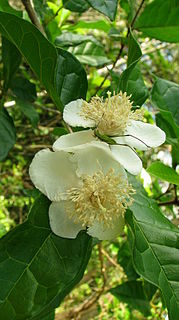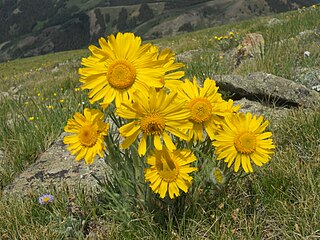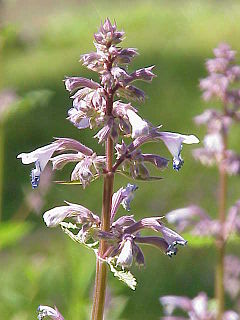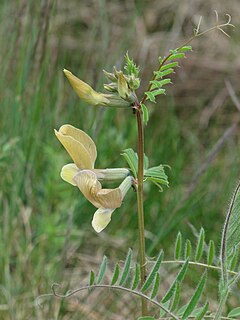
Campsis is a genus of flowering plants in the family Bignoniaceae, native to woodland in China and North America. It consists of two species, both of which are vigorous deciduous perennial climbers, clinging by aerial roots, and producing large trumpet-shaped flowers in the summer. They are reasonably hardy and do well with the support of a wall, preferring full sun.

Magnolia grandiflora, commonly known as the southern magnolia or bull bay, is a tree of the family Magnoliaceae native to the southeastern United States, from Virginia to central Florida, and west to East Texas. Reaching 27.5 m (90 ft) in height, it is a large, striking evergreen tree, with large dark green leaves up to 20 cm long and 12 cm wide, and large, white, fragrant flowers up to 30 cm (12 in) in diameter.

Portulaca grandiflora is a succulent flowering plant in the family Portulacaceae, native to southern Brazil, Argentina, and Uruguay and often cultivated in gardens. It has many common names, including rose moss, eleven o'clock, Mexican rose, moss rose, sun rose, rock rose, and moss-rose purslane.

Campomanesia is a genus in the family Myrtaceae described as a genus in 1794. It is native to South America and Trinidad.

Uvularia grandiflora, the large-flowered bellwort or merrybells, is a species of flowering plant in the family Colchicaceae, native to eastern and central North America.

Digitalis grandiflora, the yellow foxglove, big-flowered foxglove, or large yellow foxglove, is a species of flowering plant in the genus Digitalis, family Plantaginaceae. It is native to southern Europe and Asia. In mountains it grows on warm, bushy slopes or areas left after logging. The Latin specific epithet grandiflora means “large flowered”.
Campomanesia hirsuta is a species of plant in the family Myrtaceae. The plant is endemic to the Atlantic Forest ecoregion of southeastern Brazil, within Rio de Janeiro state. It is an IUCN Red List Endangered species, threatened by habitat loss.
Campomanesia lundiana, also known as the Rio de Janeiro myrtle, was a species of plant in the family Myrtaceae. Before modern extinction, the plant was endemic to Rio de Janeiro state, within the Atlantic Forest ecoregion in southeastern Brazil.

Campomanesia phaea is a species of plant in the family Myrtaceae. The plant is endemic to the Atlantic Forest ecoregion in southeastern Brazil. It is found in the states of Paraná, Rio de Janeiro, São Paulo.

Campomanesia ilhoensis is a species of plant in the family Myrtaceae.

Thunbergia grandiflora is an evergreen vine in the family Acanthaceae. It is native to China, India, Nepal, Bangladesh, Indochina and Myanmar and widely naturalised elsewhere. Common names include Bengal clockvine, Bengal trumpet, blue skyflower, blue thunbergia, blue trumpetvine, clockvine, skyflower and skyvine.

Zephyranthes minuta is a plant species very often referred to as Zephyranthes grandiflora, including in Flora of North America. The latter is, however, an illegitimate name because the original author in coining the name Zephyranthes grandiflora listed the older name Amaryllis minuta as a synonym. This makes "minuta" the acceptable epithet under the ICN. In the UK it is a recipient of the Royal Horticultural Society's Award of Garden Merit.

Hymenoxys grandiflora is a North American species of flowering plant in the daisy family known by the common names graylocks four-nerve daisy, graylocks rubberweed, or old man of the mountain. It is native to high elevations in the Rocky Mountains of the western United States, in the states of Montana, Idaho, Wyoming, Utah, Colorado, and New Mexico.

Feroniella is a genus in the family Rutaceae, the only species being Feroniella lucida. The genus is placed within Citrus by some sources, with the species becoming Citrus lucida. Feroniella lucida is a fruit-bearing tree native to Cambodia, Laos, Thailand, Vietnam and the island of Java, Indonesia.

Nepeta grandiflora is a species of flowering plant in the mint family Lamiaceae, native to the Caucasus. Growing to 75 cm (30 in) tall by 30 cm (12 in), it is a clump-forming, erect deciduous herbaceous perennial with aromatic, slightly hairy, grey-green leaves, and spikes of purple/blue flowers in early summer. Species of Nepeta are called catnip or catmint, with reference to their reported effect on some domestic cats. The plants seem to induce a euphoria in the animals, causing them to roll in the foliage and exhibit signs of intoxication.

Prunus ssiori, the Hokkaido bird cherry or Japanese bird cherry, is a species of bird cherry native to northern Japan, Sakhalin Island, and the Kuril Islands. Some natural populations may occur on the far eastern mainland of Asia in Russia. Its specific epithet derives from its Ainu name, meaning "bitter".

Campomanesia adamantium, commonly known as gabiroba, guavira, or guabiroba do campo, is a short shrub-like plant that grows no taller than 1.5 meters on average It is natively found in the central part of South America, in Paraguay and Brazil. The plant produces small yellow-green edible fruits

Vicia grandiflora, commonly known as large yellow vetch and bigflower vetch, as well as large-flowered vetch, is a common herbaceous plant species in the family Fabaceae, which occurs as a native plant species in Europe and Asia, as well as an introduced vetch species in North America.

Campomanesia guazumifolia is a species of tree in the family Myrtaceae.

Durio oxleyanus is a perennial plant species of tree in the family Malvaceae. It was once placed in the family Bombacaceae.


















